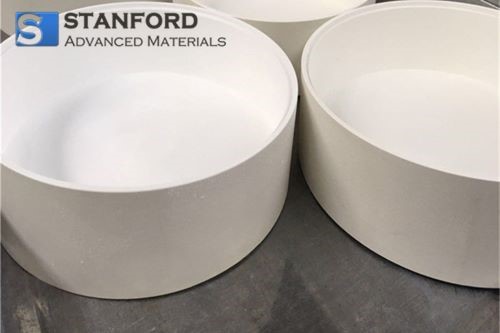Case Study: Pyrolytic Boron Nitride Crucible In Research And Laboratory
Introduction
The crucible for pyrolytic boron nitride (PBN) is a specifically designed vessel developed for research and laboratory applications within the United Kingdom. It functions as a practical tool to support a wide range of scientific experiments, from materials synthesis to high‐temperature trials. In this article, the advantages and applications of PBN crucibles for research and laboratory purposes are described in clear factual terms, thereby establishing its technical performance.

Figure 1. Research and Laboratory
Understanding the Pyrolytic Boron Nitride Crucible
PBN crucibles are engineered vessels that withstand extreme thermal and chemical conditions. Manufactured from synthetic boron nitride, these crucibles offer high thermal stability, chemical inertness, low thermal expansion, considerable mechanical strength and a high level of purity. Given that they maintain sample integrity during experiments at elevated temperatures, researchers in various disciplines depend on them for accurate results.

Figure 2. Pyrolytic Boron Nitride Crucible
Applications of PBN Crucibles in Research and Laboratory
The PBN crucible is used in different research and laboratory settings:
1. Crystal Growth: PBN crucibles are employed in processes for crystal growth, including the cultivation of semiconductor crystals, oxide crystals and other advanced materials. Their thermal stability and chemically inert surfaces help to reduce contamination and ensure consistent crystal quality.
2. High‐Temperature Reactions: The crucibles are suited to high‐temperature reactions, for example in thermogravimetric analysis, catalysis and materials synthesis. Their resistance to thermal shocks and inertness with many chemicals provide precise control during experiments.
3. Sample Preparation: PBN crucibles are used in preparing samples for X‐ray fluorescence (XRF) and alternative analytical techniques. Their non‐reactive nature ensures that analyses are reliable and repeatable.
4. Thin‐Film Deposition: PBN is applied in thin‐film deposition processes such as chemical vapour deposition (CVD) and physical vapour deposition (PVD). Their high purity and thermal stability enable controlled formation of thin films.
Case Study: PBN Crucibles for Research and Laboratory Applications
--The Challenge
A client from the semiconductor and analytical sector needed to optimise crystal growth and analytical procedures. The focus was on the growth of GaAs and InP single crystals and on performing precise chemical analyses using established methods.
--The Solution
Stanford Advanced Materials (SAM) provided a tailored solution that addressed the specific client requirements:
VGF Crucible for Crystal Growth: The vessel was designed to meet the technical demands of crystal growth with applications in both GaAs and InP systems. Its design contributed to quantifiable improvements in crystal structure and growth efficiency.
MBE Crucible for GaAs Epitaxial Layer Growth: In the process of depositing GaAs epitaxial layers via Molecular Beam Epitaxy (MBE), the emphasis was on maintaining crystal purity and ensuring chemical stability of zirconium.
LEC Crucible for High‐Purity Growth: For the production of high‐purity, undoped, semi‐insulated single or polycrystals using direct ion implantation, SAM recommended LEC crucibles (Liquid Encapsulated Czochralski), thereby standardising the growth process.
Platinum Crucible for Chemical Analysis: The platinum crucible was utilised in XRF sample preparation, ash testing, wet chemistry and Loss on Ignition (LOI) analyses. Its application resulted in increased accuracy and repeatability of chemical analyses.
--The Results
Owing to the solution provided by SAM, the client increased operational efficiency, improved crystal quality and expanded analytical capabilities. These changes led to more reliable results and enhanced competitive standing within the sector.
Conclusion
The defined properties and adaptability of the pyrolytic boron nitride crucible make it an essential tool in UK research and laboratory environments. Its use in crystal growth, high‐temperature reactions, sample preparation and thin‐film deposition contributes directly to the advancement of scientific research and innovation.
Stanford Advanced Materials (SAM) has extensive experience in manufacturing and supplying high‐performance PBN crucibles and other ceramic materials for research. For further information, please send your enquiry.

 Bars
Bars
 Beads & Spheres
Beads & Spheres
 Bolts & Nuts
Bolts & Nuts
 Crucibles
Crucibles
 Discs
Discs
 Fibers & Fabrics
Fibers & Fabrics
 Films
Films
 Flake
Flake
 Foams
Foams
 Foil
Foil
 Granules
Granules
 Honeycombs
Honeycombs
 Ink
Ink
 Laminate
Laminate
 Lumps
Lumps
 Meshes
Meshes
 Metallised Film
Metallised Film
 Plate
Plate
 Powders
Powders
 Rod
Rod
 Sheets
Sheets
 Single Crystals
Single Crystals
 Sputtering Target
Sputtering Target
 Tubes
Tubes
 Washer
Washer
 Wires
Wires
 Converters & Calculators
Converters & Calculators
 Chin Trento
Chin Trento



